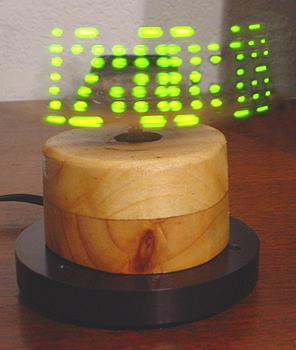Search for "Propellor Clock" for many examples of this.
A number of sites with full construction implementation are listed below.

Theory:
Propellor clocks are "just a matter of engineering" - ie the principles are well understood, "you just have to do it". The gap between knowing how and doing can be large :-) - but following some of the examples below will make it easier.
Basic process
Desired display information is converted to a dot mapped display format.
A rotor is spun horizontally or vertically.
A line of display dots (usually LEDs) are arranged in a line.
Spin speed is known or calculated.
Starting position per rotation is determined (sensor of some sort usually)
Lines of dot data are output at a rate based on rotational speed and desired display length.
All the rest is "engineering" :-)
Getting power "across the gap" may be done with a motor winding used as a power pickup (Bob Blick), induction between two coils, solar panel, brushes and slip rings, separate alternator (perhaps with a bob-weight positioned "stator" **), or ...
Information transfer can be by having it on the rotor already (clock etc), short range RF, optical, contacts (less desirable), capacitive, ... .
For external feed of dot data per rotation (as asked about) an eg 10 x (5x7) dot display = 350 dots at say 30 Hz rate x say 1/3 of an arc illuminated the data transfer rate = 350 dots x 30 Hz x 3 ~= 32 kbps. A more complex dot mapped display may need data rates of up to about 100 kbps. Such rates are certainly achievable but potentially 'annoying' to implement. The low cost of microcontrollers means that even if most processing is done external to the rotor, data speed can be much reduced by only feeding a "frame buffer" (one display of information) as required. A second buffer could be built while the current one is displaying. It may be that an acceptable compromise would be partitioning the task so that the rotor processor had all display data and implemented effects such as scrolling, flashing etc while the remote processor looked after data acquisition and management.
EXAMPLES:
One of the best known DIY versions, for which full construction details are available is "Bob Blick's propellor Clock". This was based on earlier versions by other people and in turn many people have adapted Bob's design.

Full construction details are here of Bob Blick's Propellor Clock
Here is a propellor clock site with links to a number of other related sites and designs. Some examples -

Another propellor clock - looks useful - Neelandans? propellor clock

Instructables on motor implementation. Note this comments on bob Blick's use of an extra coil for powering the electronics.
And again - horizontal orientation - another Bob Blick inspired design

132 LED driver IC !!!!
I just heard (October 2011) on PICList (thanks Colin) about this IC . 132 LED driver from Austrian Micro. Digikey sells a number of their ICs but do not list this one as yet.
They say:
The AS1130 is a compact LED driver for 132 single LEDs. The devices can be programmed via an I²C compatible interface.
The AS1130 offers a 12x11 LED-Matrix with 1/11 cycle rate. The required lines to drive all 132 LEDs are reduced to 12 by using the cross-plexing feature optimizing space on the PCB.
The whole LEDMatrix driving 132 LEDs can be analog dimmed from 1 to 30mA in 256 steps (8 bit). Additionally each of the 132 LEDs can be dimmed individually with 8-bit allowing 256 steps of linear dimming.
To reduce CPU usage up to 36 frames can be stored with individual time delays between frames to play small animations automatically.
The AS1130 operates from 2.7V to 5.5V and features a very low shutdown and operational current. The device offers a programmable IRQ pin. Via a register it can be set on what event (CP request, Interface timeout, Error-detection, POR, End of Frame or End of Movie) the IRO is triggered. Also hardware scroll Function is implemented in the AS1130.
The device is available in a ultrasmall 20-pin WL-CSP and an easy to solder 28-pin SSOP package.
Product page / General details here
Data sheet here
http://www.austriamicrosystems.com/eng/led-driver/AS1130






